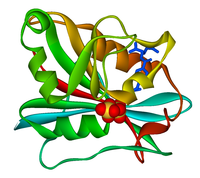
Photo from wikipedia
A new thiosemicarbazone ligand was synthesized and characterized using spectroscopic techniques (UV-Vis and IR) and synchrotron x-ray powder diffraction. With M2+ = Mn2+, Zn2+ and Cd2+, coordination compounds of the type (M[L]2)… Click to show full abstract
A new thiosemicarbazone ligand was synthesized and characterized using spectroscopic techniques (UV-Vis and IR) and synchrotron x-ray powder diffraction. With M2+ = Mn2+, Zn2+ and Cd2+, coordination compounds of the type (M[L]2) were isolated. In the presence of sodium dithiocarbamate salts (NadiEtdtc.3H2O = sodium diethyldithiocarbamate trihydrate and Napipdtc = sodium piperidinedithiocarbamate), Zn2+ and Cd2+ were able to form ternary octahedral complexes where each metal binds a deprotonated (thiosemicarbazone) ligand, a monobasic dithiocarbamate ligand and a water molecule. In vitro biological evaluation tests of the free HL ligand and its metal complexes against selected fungal and bacterial cultures were performed. Compared with HL, the complexes displayed enhanced biological activities and ternary Zn (II) complexes displayed comparable antibacterial activities to the chloramphenicol standard.
Journal Title: Future medicinal chemistry
Year Published: 2018
Link to full text (if available)
Share on Social Media: Sign Up to like & get
recommendations!